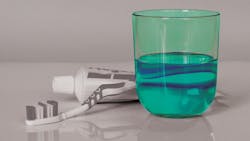Modern oral rinses: A revolution in dentistry
Oral rinsing has been a staple of American life since the early 1900s.1 Think about that for a minute—we’re talking about a time when the average family had an annual income of $3,000, no phones, no car, and no indoor plumbing. And yet, more than a century later, oral rinsing remains foundational to overall health care.
But today’s offerings aren’t your (great) granddaddy’s oral rinses! Nothing less than a revolution in oral rinsing has taken place, thanks in no small part to innovative technologies and consumer demand.1 New products are frequently released and new formulations of existing products are constantly tested, all accompanied by what seems like a deluge of trendy flavors to entice users to remain compliant.
We’ve seen past products turn up in repackaged forms and new, somewhat unusual trends emerge—such as oil pulling—that have dental professionals everywhere investigating the latest clinical research. With promises of antiseptic, anticavity, analgesic, and anti-inflammatory properties, modern oral rinses are now typically multipurpose solutions that play a crucial role in maintaining oral health. But as we’ll discuss below, we are now finally recognizing the role oral rinses have in keeping the dental hygienist safe while providing clinical care.
Dental hygienists already know that oral rinsing is one of the most compliant home-care regimens we can recommend to our patients (beyond basic brushing, of course). We know how important it is to customize our professional recommendations for each individual patient based on their personal needs, behavioral characteristics, and health habits. We also know that oral rinses can be as different from one another as the sun is from the moon. Depending on the active ingredients, oral rinses can be prescription, over the counter, or purchased only at dental practices. According to the Federal Food, Drug, and Cosmetic Act, oral rinses can also be classified as a drug, cosmetic, or both depending on their intended use.2
In October 2020, an informal survey was completed within the American dental industry to observe the most popular ways dental professionals currently use oral rinses in a post-COVID-19 environment. Not surprisingly, by far the most popular method was the use of oral rinse as a preprocedural rinse. The reason? Preprocedural rinsing is widely known to significantly decrease oral microbes.
Additionally, an exciting new study released on July 1, 2020, suggests that activated chlorine dioxide, found in OraCare Health Rinse, is effective against human coronavirus. The activated chlorine dioxide in OraCare was found to reduce human coronavirus by 99.99% in as little as one minute, with reduction lasting through the 60-minute mark.3 Results like these indicate that OraCare is a great preprocedural rinse, as it not only decreases the amount of microbes in the oral cavity but may also help decrease the amount of pathogenic microbes that remain.
Having moved well beyond their early 20th century origins, clinical technologies continue to evolve, and innovative oral rinses are emerging that can now help treat multiple conditions simultaneously.
Consider, for instance, the pseudonymous case study of Jane Tooth, a 52-year-old Caucasian female who struggles with obesity and a high-carbohydrate diet. Jane presents with a history of periodontal disease, does not floss, has a family history of heart disease, and has recently been complaining of dry mouth. She says she doesn’t like to get close to other people because she is embarrassed about her bad breath. Jane visits her dental hygienist every three months for periodontal maintenance and is due for a comprehensive oral evaluation, full-mouth radiographic imaging, and periodontal charting.
For Jane, oral rinsing should remain a critical component of both the clinical appointment and her at-home care regimen. During the clinical appointment, the dental hygienist should use an oral rinse as a preprocedural rinse or as a postprocedural irrigation after providing therapeutic care. Unsurprisingly, the dental hygienist should also recommend daily rinsing at home. In this case, a rinse can be chosen that helps improve oral malodor, likely increasing Jane’s compliance.
It is more important than ever for multipurpose oral rinse formulations to minimize or negate harmful side effects. While old staple rinses, such as iodine and hydrogen peroxide, boast an array of side effects, many newer rinses, such as chlorhexidine, can be known for staining, altering taste, and even oral irritation. Thankfully, the activated chlorine dioxide found in OraCare is safe for human tissue, for in the same study mentioned before, findings conclude that there is zero cell toxicity at 60 minutes, rendering activated chlorine dioxide wholly safe for the human body.3
As oral rinses continue to evolve and remain household staples well into the future, it’s important to find ways for dental hygienists to continue incorporating them into clinical care. It’s also equally important to continue recommending oral rinses to our patients as at-home care and an adjunct to brushing and interdental cleaning. What a revolution in oral rinsing!
Editor's note: This article is sponsored by OraCare. Content has been reviewed for editorial integrity per RDH guidelines. For more information on our editorial standards, see rdhmag.com/page/submission-guidelines.
References
- Prichard D. A brief history of mouthwash. Spear Education. December 14, 2012. https://www.speareducation.com/spear-review/2012/12/a-brief-history-of-mouthwash
- Is it a cosmetic, a drug, or both? US Food and Drug Administration. https://www.fda.gov/cosmetics/cosmetics-laws-regulations/it-cosmetic-drug-or-both-or-it-soap
- Smith T. Standard test method to assess the activity of microbicides against viruses in suspension. Microchem Laboratory. July 1, 2020. https://www.oracareproducts.com/uploads/4/3/7/3/43731917/human_corona_virus_study.pdf
MELISSA TURNER, BASDH, RDHEP, EFDA, an award- winning thought leader, influencer, and dental advisor, is cocreator of Care for a Better Tomorrow. She is chief hygiene officer for Cellerant Consulting and is a nationally published author and speaker. Cofounder of the National Mobile & Teledentistry Conference and the American Mobile & Teledentistry Alliance, Turner is the creator of the I Heart Mobile Dentistry Facebook community and is affectionately known on Instagram as @thetoothgirl. She can be reached at [email protected].
About the Author

Melissa Turner, BASDH, RDHEP, EFDA
Melissa K. Turner, BASDH, RDHEP, EFDA, was honored as a 2024 Marquis Who's Who in America recipient. She is Senior Executive Consultant at Cellerant Consulting Group and spearheads the Cellerant Best of Class Hygiene Awards. She is a founding board member of the American Mobile & Teledentistry Alliance, cochair of the Oral Health Prevention Summit, and serves on the executive board of the Dental AI Association. Known as @thetoothgirl, she is the cofounder of The Denobi Awards and the National Mobile & Teledentistry Conference.
